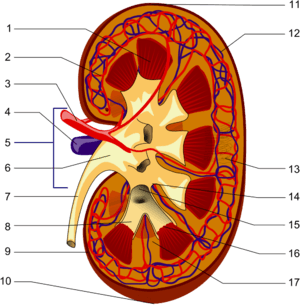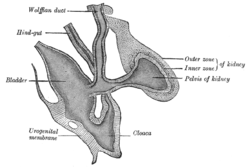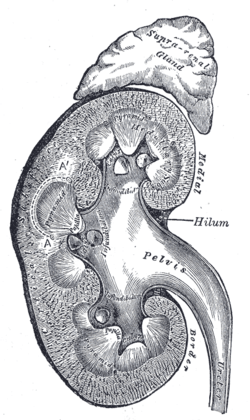Renal pelvis
| renal pelvis | |
|---|---|
 Frontal section through kidney. | |

| |
| Details | |
| Precursor | Ureteric bud |
| Identifiers | |
| Latin | pelvis renalis |
| MeSH | A05.810.453.537 |
| TA | A08.1.05.001 |
| FMA | 15575 |
The renal pelvis or pelvis of the kidney is the basin-like or funnel-like dilated proximal part of the ureter in the kidney.
In humans, the renal pelvis is the point of convergence of two or three major calyces. Each renal papilla is surrounded by a branch of the renal pelvis called a calyx.
The major function of the renal pelvis is to act as a funnel for urine flowing to the ureter.
The renal pelvis is the location of several kinds of kidney cancer.
Its mucous membrane is covered with transitional epithelium, and an underlying lamina propria of loose to dense connective tissue.

Additional images
 Primitive kidney and bladder, from a reconstruction.
Primitive kidney and bladder, from a reconstruction. Vertical section of kidney.
Vertical section of kidney.- Renal pelvis
- Renal pelvis
Etymology and pronunciation
Like the bony pelvis, the renal pelvis (/ˈriːnəl/ /ˈpɛlvᵻs/) gets its English name via New Latin from the older Latin word pelvis, "basin", as in "wash basin".[1] In both cases the name reflects the shape of the structure, and in the case of the renal pelvis, it also reflects the function. The name reflects that each renal pelvis collects urine from the calyces and funnels it into the ureter like a wash basin collects water and funnels it into a drain pipe. The renal pelvis is occasionally called the pyelum (from Greek πυελος pyelos, "pelvis"), and the combining form pyelo- denotes the renal pelvis (pyelo- is not to be confused with pyo-). The words infundibulum and choana are other words for funnel-shaped cavities (which medical English got from the Latin and Greek words for "funnel", respectively), and the renal pelvis is sometimes called the renal infundibulum. The form *renal choana is logical but is not used.
See also
- Staghorn calculus
- Renal sinus
- Hydronephrosis
- Pyelectasis, the dilation of the renal pelvis
Notes
References
- ↑ Merriam-Webster, Merriam-Webster's Unabridged Dictionary, Merriam-Webster.
External links
- Anatomy figure: 40:03-07 at Human Anatomy Online, SUNY Downstate Medical Center—"Section of the kidney, anterior view."
- Anatomy image:8962 at the SUNY Downstate Medical Center
- Anatomy photo: Urinary/mammal/pelvis0/pelvis1 - Comparative Organology at University of California, Davis—"Mammal, renal pelvis (Gross, Medium)"
- Anatomy photo: Urinary/mammal/pelvis1/pelvis1 - Comparative Organology at University of California, Davis—"Mammal, renal pelvis (LM, Medium)"